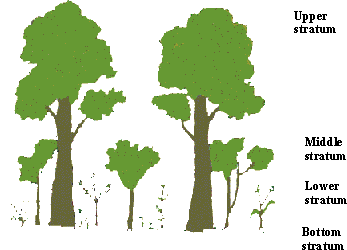In any biotic community, the animals and plants are observed
to be arranged in vertical strata or layers, called community stratification.
Each layer or zone shows characteristic plants and animals. This stratification
is based upon the light intensity, capacity to stand hydrostatic pressure
and temperature, etc.
The stratification of a lake can be studied in
three zones as follows:
i.The littoral zone and sublittoral zone
are the shallow water zone which is penetrated by light. It usually
extends about 10 meters downwards. This zone includes plants which
are rooted at the bottom but some of them grow above the surface
of water. The plants included in this zone are Nymphaea,
Hydrilla, Chara, Vallisneria etc. Many unicellular
algae like diatoms and Nitella are also seen in this zone. The fauna
supported by the plant community of this zone induces fish, frogs,
larvae, some bivalves, snails etc.
ii. The limnetic zone : This is the open
water zone or surface water area . It is well illuminated and supports
floating forms like leaves of rooted plants of the littoral zone,
with plankton, nekton and other free floating organisms which are
plankton feeders. For example, blue algae, blue-green algae, some
protozoans, diatoms, Pistia, Eichhornia and other
animals like Cyclops, daphnia, larvae of insects and plankton and
nekton eating small fish.
iii. The profundal zone : This is the
bottom of a lake where light does not reach. This zone includes
consumers and decomposers but not producers. It includes
animals like tapeworms, sponges, some clams. Since it contains the
dead bodies of plants and animals it has an abundance of decomposers
i.e. bacteria and fungi. A few fish also visit this area for eating
detritus.
Ponds and lakes in particular show a number of
abiotic components like minerals and salts dissolved in water and
in the bottom mud and soil. It also shows biotic communities like.
-
Producers, like phytoplanktons, algae,
floating plants, and rooted submerged plants.
-
Herbivores , like larvae of insects
and omnivores like frogs.
-
Primary consumers , like zooplankton,
snails, worms and crustaceans.
- Secondary consumers, like aquatic insects, small fishes
frogs etc.
-
Tertiary consumers, like large fishes,
carnivorous birds which feed on small fishes.
Besides these, there are number of parasites and
saprophytes as well as decomposers like fungi and bacteria in this
ecosystem.
Communities of a forest: A forest is a large
tract of land covered chiefly with trees and undergrowth. The green
earth is blanketed with forest wherever there is sufficient moisture
and suitable temperature for trees to grow.

Figure 25.7 Stratification of Forest
A deciduous forest is a biome of abundant
rainfall, moderate temperature with warm summers and cold winters,
and humid, with rain. The vegetation consists of deciduous trees
like oak, elms, and walnut along with low underbushes, vines and
scattered evergreen trees. The characteristic animals are deer,
fox, bear, flying squirrel, wild cat, small birds, snakes and amphibians.
Many insects and other invertebrates are also found taking shelter
in decaying logs.
A tropical rain forest is a biome of much
rain and constant humidity. There are many species of evergreen
trees with large broad foliage leaves continuously growing all the
year round. Because the floor is overshadowed by trees it is exceedingly
humid and dark and populated by plants requiring minimum light.
The characteristic animals are monkeys, amphibians, insects, snails,
leeches, scorpions, reptiles and birds.